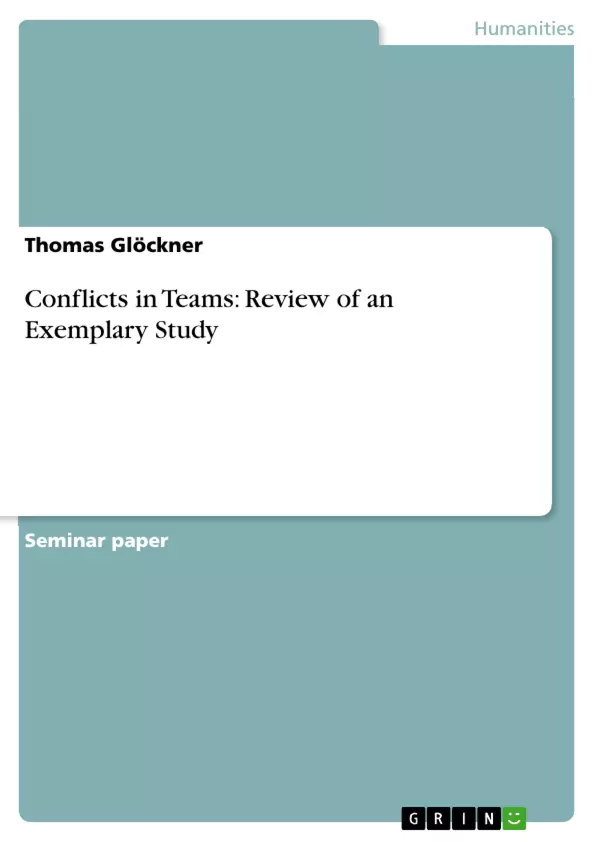“The point is not how to eliminate or prevent conflict but rather how
to make it productive.” Morton Deutsch
1 Introduction to Conflict
Conflict is found in all realms of social interaction and is therefore an important topic for all kinds of social scientists. Thus, there are various definitions of conflict. As Deutsch (1973) simply puts it: “A conflict exists, whenever incompatible activities
occur.”(1) Pruitt (1998) distinguishes two categories(2):
a) definitions referring to conflict behavior – opposing actions taken by two (or more) parties (close to Deutsch´s view)
b) definitions referring to sources of conflict behavior – most commonly divergence of interest and annoyance that is attributed to another party As can be seen from these quite broad definitions, conflict is a term that can be applied to numerous situations in daily life. A couple trying to figure out where to vacation (if for example he wants to spend the holidays in a cabin in the mountains
and she prefers staying in a luxury hotel at the Cote d´Azur) as well as the arms race between the Soviet Union and the US during Cold War can be considered a `conflict´.
[...]
______
1 p.10
2 p.470
Inhaltsverzeichnis (Table of Contents)
- Introduction to Conflict
- Review of "A Multimethod Examination of the Benefits and Detriments of Intragroup Conflict" by Karen A. JEHN
- Present Findings & Definitions
- Design of the Study
- Methods
- Hypotheses & Theoretical Background
- Results
- Discussion & Conclusion
- Links and Relations to `Center of Excellence'
- References
Zielsetzung und Themenschwerpunkte (Objectives and Key Themes)
This seminar paper aims to review and analyze the findings of Karen A. Jehn’s study on the benefits and detriments of intragroup conflict, published in the Administrative Science Quarterly. The paper examines how conflicts within teams can be both beneficial and detrimental, exploring the factors that influence these outcomes. This analysis aims to contribute to a deeper understanding of the complex dynamics of team conflict in organizational settings, drawing connections to the “Center of Excellence” model.
- The multifaceted nature of conflict in teams
- The potential benefits and detriments of intragroup conflict
- The impact of conflict on team performance and effectiveness
- The relationship between conflict and organizational culture
- The application of conflict research to the “Center of Excellence” model
Zusammenfassung der Kapitel (Chapter Summaries)
The first chapter introduces the concept of conflict in social interaction, highlighting its significance for social scientists. Different definitions of conflict are presented, emphasizing the wide range of situations to which this term can be applied. The chapter then explores the often-overlooked positive aspects of conflict, showcasing its potential for personal and social growth.
The second chapter delves into a detailed review of Karen A. Jehn’s seminal study on intragroup conflict. The chapter outlines the study’s objectives, design, and methodology, highlighting Jehn’s innovative use of both quantitative and qualitative methods. The chapter also explores the study’s key findings, focusing on the interplay of conflict and its effects on team performance.
The third chapter examines the links and relations between the findings of Jehn’s study and the “Center of Excellence” model. The chapter explores how the insights gained from the research can be applied to the context of organizational development and leadership. This chapter aims to demonstrate the practical relevance of the study and its implications for building successful and high-performing teams.
Schlüsselwörter (Keywords)
The key focus of this paper lies in exploring the intricacies of conflict in teams. This includes investigating both the potential benefits and detriments of intragroup conflict, examining its impact on team performance and effectiveness, and drawing connections to relevant theories and models such as the “Center of Excellence” model. The study by Karen A. Jehn, which employs a multimethod approach to analyze the dynamics of intragroup conflict, serves as the central point of reference for this analysis. This paper explores the complex interplay between conflict, team dynamics, and organizational performance, highlighting the significance of understanding and managing conflict for achieving organizational success.
- Citar trabajo
- Thomas Glöckner (Autor), 2000, Conflicts in Teams: Review of an Exemplary Study, Múnich, GRIN Verlag, https://www.grin.com/document/614



